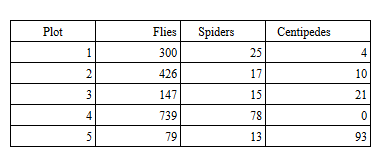The most plausible explanation for the high number of spiders in plot 4 is:

A. there are too many flies overall.
B. there are no centipedes to prey on the spiders and there are abundant flies upon which to feed.
C. the spiders preyed on the centipedes and ignored the flies.
D. the flies and spiders worked together to eliminate the centipedes
Clarify Question
1. What is the key concept addressed by the question?
2. What type of thinking is required?
3. What key words does the question contain and what do they mean?
Gather Content
1. What do you know about food webs?How does it relate to the question?
Consider Possibilities
1. What other information is related to the question? Which information is most useful?
2. Which food webs make sense?
choose Answer
1. Given what you now know, what information and/or problem solving approach is most likely to produce the correct answer?
Reflect on Process
1. Did your problem-solving process lead you to the correct answer? If not, where did the process
break down or lead you astray? How can you revise your approach to produce a more desirable result?
B. there are no centipedes to prey on the spiders and there are abundant flies upon which to feed.
Clarify Question
1. The question is about a food web.
2. This question is asking to analyze data on a food web.
3. Flies – prey for spiders
Spiders – prey for centipedes and predators of flies
Centipedes – predators of flies and spiders
Gather Content
1. In a food web an organism
will often be prey for some species and a predator of others. As a result the abundance of prey and predators can both influence the numbers of a specific species.
Consider Possibilities
1. If flies are at the bottom of the food web they will not consume other species, but serve as a food
supply for them. Spiders are in the middle of the food web and their numbers are influenced by the levels of prey (flies) and predators (centipedes).
2. Centipedes are the top predators in this food web and their
numbers can be affected by the abundance of prey (flies and spiders).
Choose Answer
1. The best answer is that there are a lot of flies (prey) and few predators(centipedes) which leads to an abundance of spiders.
Reflect on Process
1. This question asked you to analyze data on a food web to draw specific explanations for the
results. To do this you needed to recognize which species were predators and which were prey. If you got
the correct answer, great job! If you got an incorrect answer, where did the process break down? Did you think that flies were not at the bottom of the food web, or centipedes were not at the top of the food web?
You might also like to view...
. If the efficiency of the alveoli in an human was reduced by 50%, what would you predict would be the effect?
A. The volume of air in the lungs would decrease by 50%. B. The rate of gas exchange would decrease by 50%. C. The affinity of hemoglobin for oxygen would decrease by 50%. D. The muscular control of breathing would decrease by 50%.
Which of the following is NOT the description
of a human disease caused by roundworms?
a. lymph vessels permanently destroyed causing elephant-like legs b. causal agent lives in rectum; females lay eggs in skin around the anus c. infection results from eating uncooked pork d. intestinal blockage disease affecting more than a billion people e. all of these are human diseases caused by roundworms
In which phase of mitosis are the chromosomes lined up on the equator?
a. anaphase b. prophase c. cytokinesis d. telophase e. metaphase
When a nerve impulse travels from neuron 1 to neuron 2, neuron 1 is known as the _____
a. postsynaptic neuron b. presynaptic neuron c. synapse d. gated channel e. dendrite